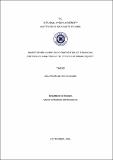DSpace Repository
INVESTOR BEHAVIOR AND COMPOSITION OF FINANCIAL PORTFOLIO: ANALYZING THE EFFECTS OF BRAND EQUITY.
JavaScript is disabled for your browser. Some features of this site may not work without it.
| dc.contributor.author | GYEABOUR, SOLOMON ANTI
|
|
| dc.date.accessioned | 2021-05-04T08:27:08Z | |
| dc.date.available | 2021-05-04T08:27:08Z | |
| dc.date.issued | 2020 | |
| dc.identifier.uri | http://hdl.handle.net/11547/7547 | |
| dc.subject | Brand equity | tr_TR |
| dc.subject | Perceived risk and return | tr_TR |
| dc.subject | Portfolio Management | tr_TR |
| dc.title | INVESTOR BEHAVIOR AND COMPOSITION OF FINANCIAL PORTFOLIO: ANALYZING THE EFFECTS OF BRAND EQUITY. | tr_TR |
| dc.type | Thesis | tr_TR |
| dc.description.abstractol | There are numerous studies that have been conducted to contribute to the literature on the marketing and finance fields separately. Specifically, branding and behavioral finance are among these fields gaining increasing research attention. Most of these researchers’ interest hinges on their quest to investigate how players in the economic environment respond to vulnerabilities posed by the economy. In recent times, there exist a lot of economic vulnerabilities in Turkey and Ghana which calls for caution and stringent measures to ensure monies invested in these economies yield their anticipated returns. Can branding be used to reduce the effects of these vulnerabilities on the investor decision making? The main purpose of this study is to undertake an investigation into investors' behaviors whilst analyzing the effects of asset-related brand equity on managing their portfolio of financial assets and mediating roles of perceived return and risk in this relationship in a comparative analysis between two developing economies. The study is conducted via an online survey among educated adults who currently hold, have previously held, and or intend to hold an investment instrument of any kind in Ghana and Turkey. To this end, the relationship between brand equity dimension (brand awareness), perceived return and risk, investor experience and income levels were tested. The population for the study comprised of all educated Ghanaians and Turkish, who fall in the above category. In order to scale down this large population, the Cochran’s formula was used to define the ideal sample size. In total 472 responses were used in the analysis. After ascertaining the reliability and validity of the data using the confirmatory factor analysis (CFA), the structural equation modeling (SEM) technique was used to test the structural relationship between the measured variable (portfolio management) and dominant variable (brand awareness). The results show that brand equity dimensions of financial assets is a vital construct that significantly influences investors' behavior, and shapes the construction of the ideal portfolio of financial assets. Also, the study showed that perceived risk and return played a mediating role between brand awareness and portfolio management in developing economies, while investor income level is seen as a moderator for the brand awareness-portfolio management relationship in the Ghanaian case. This study presents a practical implication on the relevance of strategically positioning financial asset brands and making vital adjustments to the management of ‘‘brand-related influencers’’ with regards to making investment moves | tr_TR |
Files in this item
This item appears in the following Collection(s)
-
Tezler -- Thesis [3470]
